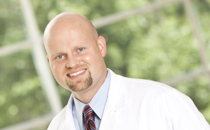We can all agree that — out of the thousands of different things that can go wrong with the human body — problems with breathing rank right up there at the top. If you can’t breathe, you’ve got a serious problem. That’s why the science of pulmonology and the experts who practice in this field are so important to our overall health.
 We interviewed Dr. Jason McKinney, a pulmonologist practicing at Mercy, and Staci Hopper, an advanced practice registered nurse (APRN), to get insight on what a typical “day in the life” is like for experts who specialize in keeping
We interviewed Dr. Jason McKinney, a pulmonologist practicing at Mercy, and Staci Hopper, an advanced practice registered nurse (APRN), to get insight on what a typical “day in the life” is like for experts who specialize in keeping  patients breathing easy.
patients breathing easy.
What types of conditions and problems do pulmonologists treat?
Pulmonologists most commonly treat COPD (chronic bronchitis, emphysema), Asthma, Bronchiectasis, Interstitial lung disease, Occupational lung disease, Pulmonary Hypertension, Complex Lung Infections, Pulmonary fibrosis, and Sarcoidosis. They often are part of the team diagnosing lung cancer and they help manage its complications.
What are the tests pulmonologists use to diagnose the problem?
Common diagnostic testing includes pulmonary function tests, chest x-rays, CT scans, blood work and sometimes using a bronchoscope to look inside the airways.
Asthma can be a scary condition for kids and parents. What are the red flags parents should watch for that might indicate a problem?
Some red flags parents should watch for include: Shortness of breath that worsens during physical activity, cough, chest tightness, reduced exercise tolerance or prolonged recovery time following exercise, excessive fatigue, and/or wheezing.
What are the latest advancements in the treatment of asthma in kids and adults?
There have been several new inhaled medicines useful in asthma over recent years. There is also some newer injection therapies available for more resistant cases.
What is COPD and who does it usually affect?
COPD stands for Chronic Obstructive Pulmonary Disease and is often a mix of chronic bronchitis and emphysema. In chronic bronchitis, the airways get inflamed and make a lot of mucus. This can narrow or block the airways, making it hard to breathe.
In emphysema, the air sacs are damaged and lose their stretch and ability to absorb oxygen as well. Less air gets in and out of the lungs, which makes the patient feel short of breath.
By far, the most common cause of COPD is smoking. Other causes include secondhand smoke, pollution and fumes, genetics, and asthma. Because COPD develops slowly, it is frequently diagnosed in people aged 40 or older.
What can patients do to prevent the likelihood of developing COPD?
The number one way to prevent COPD, or slow it down if you already have it, is to STOP SMOKING. If you have serious lung symptoms with no clear cause (like smoking) you might need testing for “Alpha one antitrypsin deficiency.”
What do you wish more people understood about lung health?
The biggest thing people need to know is that prevention and early intervention is key. Many lung diseases can be prevented by making good lifestyle choices like not smoking, maintaining a healthy weight and routine exercise and wearing protective equipment when dealing with particles or fumes. If someone is having respiratory symptoms, they need to discuss them with their primary care physician. Many pulmonary problems can be very effectively managed by their primary care physician but for some resistant, complicated, severe or unusual cases, a person may need to see a pulmonologist.
Our thanks to Dr. Jason McKinney for answering our questions about breathing problems, prevention and treatment. To schedule an appointment with Dr. McKinney, call his office at 479-338-3080 or click here for more info on the clinic.







